 TRIZ
Textbooks: CID Course for Children, 3-2G1 TRIZ
Textbooks: CID Course for Children, 3-2G1 |
  
|
| Topic 1.
Modeling with Smart Little People |
Planet
of Unsolved Misteries:
Course of Creative Imagination
Development (CID),
3rd Grade, 2nd Semester,
Methodical Guide-Book |
Natalia
V. Rubina, 1999 [published
in Russian]
English
translation by Irina Dolina,
Jun. 17, 2001
Technical
Editing by Toru Nakagawa, Feb.
16, 2002 |
Posted
in this "TRIZ Home Page in Japan" in English on Feb. 19, 2002 under the
permission of the Author.
(C) N.V. Rubina,
I. Dolina, and T. Nakagawa 2002.
Lesson 3 was
inserted on Mar. |
 |
Topic
1. Modeling with Smart Little People |
Lesson 1.
Workbook
1. Warming-up
(Card index to the CID lessons for third grade)
3. Introduction to the lesson.
Problem 1. “a disappeared parcel”
The post office receives the parcels that have notice that
their weight is 8 kilograms and their value is rather high. Actually,
their weight turned to be much less. The customer demanded compensation
for the damage. What’s wrong?
Let’s consider the problem about a ”disappeared
parcel”.
IF
a parcel becomes rotten during transportation,
THEN its weight decreases,
BUT this will be noticeable
at once.
Find opposite properties:
A parcel must be heavy, to be announced valuable,
And it must be light to let its receiver demand compensation for the
loss.
Articulate an ideal solution:
The parcel is losing its weight by ITSELF.
What resources exist for solution of this
problem:
the contents of the parcel.
Method of solving contradictions:
in time – first it is heavy, then later it is light.
Solution:
(If you have already guessed the clue of this nearly detective
problem, write down your solution.)
Contents of the parcel is dry ice.
4. Main Topic
“Methods of overcoming psychological
inertia, used in TRIZ seem purely psychological. Indeed, the essence
of these methods is in the fact that they point the direction of evolution
of technical systems.
About thirty years ago an American scholar,
William Gordon, suggested a special method for solving inventive problems
– empathy. The core of this method is in the fact that one imagines
oneself a machine, discussed in the problem, accustoms oneself to the image
of this machine and tries to look for a solution playing with this machine.
This is a purely psychological method, providing an unusual view of this
problem and helping to see something new.
We decided to test Gordon’s idea,
conducted some experiments. It turned out that empathy sometimes
helped to find a solution, but more often it led to a deadlock. When
a researcher imagines himself a machine, he begins to avoid the ideas implying
its breaking, division, fragmentation, melting, freezing… For a living
organism these actions are unacceptable and banned. And a person
naturally transfers this ban to the machine. But the machine and
its parts can be divided, fragmented and so on.
Instead of empathy, Smart Littel People
are being used in TRIZ. The method is very simple: one has to imagine
that an object (a machine, a device, etc.) is a crowd of Smart Little People.
It reminds of an empathy to some extent: one can look at the problem from
“inside”, through the eyes of the smart littel people. But this is
an “empathy without an empathy”; there are no drawbacks, characteristic
to the empathy. The ideas of division, fraction, and fragmentation
are easily perceived: a crowd of Smart Little People can be easily divided,
reconstructed…
Modeling with Smart Little People requires
a strong imagination. One has to imagine that an object consists
of a team of Smart Little People – neither of molecules, nor of atoms,
but of living and thinking creatures. What do they feel? How
should they act? How does a team should act? This is a very
convenient model for thinking! If, of course, you have skills for
working with such a model”.
(G. Altov: “And Suddenly the Inventor Appeared", “Detskaya
literatura”, Moscow, 1989, p.83-84).
Today we’ll learn the method that helps us to
handle easily this problem.
But first a little bit of history.

“Once in London, Fridrih August Kekule
tells about a discovery that accounted for the structure of many complicated
matters of a human body and of all living creatures: I sat in an
omnibus thinking how to present a benzene molecule in a structure formula
that meets the requirements of its properties. At that moment I saw
a cage with the monkeys that were catching each other: they snatched each
other, then disassembled, one moment they snatched each other in such a
way that made a circle. Each of them was holding to the cage with
one leg and the other one was holding its another leg with both hands,
their tails were loose and waving. So, five monkeys, holding each
other, formed a circle, and an idea immediately came to my mind: this is
a picture of benzene. This formula explains the strength of a benzene
ring.”
There are many similar examples where modeling
with parts of a system containing contradictions helped researchers solve
difficult problems in science and technology.
Let’s imagine that any of the objects surrounding
us consists of many very small men (Smart Little People).
  |
Chalk consists of solid small men, they hold each other
by hand. |
 .
. |
Water consists of liquid small men, they don’t hold each
other by hand but stand close to each other. |
 |
Air consists of gaseous small men, they are restless
and run fast all the time. |
And what if we try to imagine the contents
of the parcel consist of small men.
First they have to be heavy and were safely
placed in a parcel box. What are they like? Of course, they
are solid.
Then a parcel arrives at its destination.
The small men should decrease or better disappear, then the parcel
will become very light. What kind of small men can disappear without
a trace from the box? Right, if they are gaseous.
Thus, first – solid, then – gaseous.
The substance that from solid can turn into gaseous is dry ice (street
ice-cream sellers have much dry ice in their small carts). Of course,
a swindler was exposed at the post office, very simple – it was dry ice!
Try to solve the following problem using Smart
Little People.
Problem 2.
Winter of 1942. A military plant, having evacuated to
the Uralls, is going to assemble the equipment on a new place. A
big heavy press has to be put into a deep pit. There is no crane
at hand; its transportation will take too much precious time. What
should be done?
A contradiction:
If
the press is pushed into a pit,
Then (+) the press would be in a proper place,
But (–) the press might be damaged.
IFR (Ideal Final Result):
The pit carefully puts down the press by itself.
Contradiction 2:
The pit should be filled with some substance to prevent the
press from falling, and it should not be filled some substance to let the
press sink into the pit.
| Using Smart Little People, draw
a picture of a system where the contradiction has emerged. |
|
| What should the Smart Little
People do to solve this Contradiction? |
|
7. Sum up
Homework.
Problem 3.
It is necessary to make many holes
of 10 mm in diameter in a long rubber pipe. Generally it is not too
difficult to drill holes. But rubber is supple; it stretches, shrinks,
curves… It is very difficult to make a hole of required size. The
worker tried to burn a hole with a burning rod, but the edges of the hole
were burning and crumbling.
"I can’t handle it!", cried the worker with
annoyance. "I am going to cry…"
And at this point the Inventor appeared.
"You don’t have to cry!", he said in surprise.
"This is very simple!"
What did the Inventor suggest?
A contradiction:
IFR (Ideal Final Result):
Contradiction 2:
| Using Smart Little People, draw
a picture of a system where the contradiction has emerged. |
|
| What should the Smart Little
People do to solve this Contradiction? |
|
Workbook
Lesson 2
1. Warm-up
(Card index to the CID lesson for the third grade).
2. Homework check up
(Considering the homework problem.)
3. Introduction to the lesson
Using Smart Little People one can devise very
interesting riddles:
What is it?
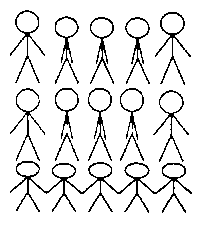 |
Your suggestions: |
| (A glass of water) |
The picture has changed a little. What
can it be?
 |
Your suggestions: |
| (A glass of water with gas) |
Make up your riddles, and draw them using the
Smart Little People. Of course, you can draw your riddles with your
own small men; however in Appendix 2 you will find many Smart Little People.
If you cut them out, you will be able to lay them together in your riddles
like puzzles.
We know well that all systems change in time.
The next riddle of mine is about these changes.
| Finish the picture (a hint: this picture is typical for nature). |
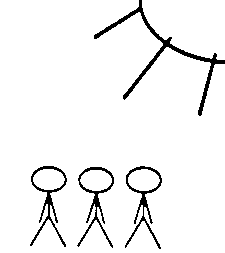 |
|
| Some time later some small men changed. Why? |
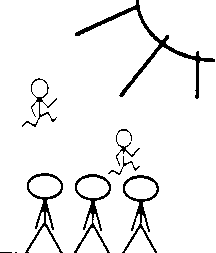 |
|
| What happened to the men? Finish the picture. |
 |
|
| Then the following thing happened to the small men. |
 |
|
| The small men got into this picture. Finish it. |
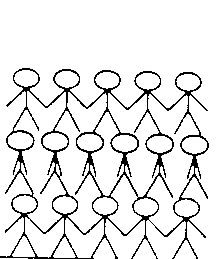 |
|
| What is the difference between the first picture and the last? |
 |
|
These six screens with the help
of the small men show some phenomena dealing with water rotation in nature.
Working with these illustrations at the lessons of science makes many rather
complicated natural phenomena understandable for the children. In
“Card index to the CID lessons for third grade, part 2”, there are several
experiments with the plants, minerals, and some chemicals, together with
commentaries (Modeling with Smart Little People). The children may
choose Modeling with Smart Little People as a project, elaborated at the
CID lessons.
Using the Smart Little People, draw a picture
of the processes changing in time.
Workbook
Lesson 3
1. Warm-up
(Card index to the CID lesson for the third grade).
2. Homework check up
(Reviewing the homework problem)
3. Introduction to the lesson
The Smart Little People are reliable assistants
in solving problems. Using the patterns of solving problems and the
help of the small assistants we will manage even the most difficult problems.
In “Card index to the CID lessons for the
third grade, part 2” there is a selection of the problems that will help
you to practice Modeling with Smart Little People.
“The image-bearing mode of
thinking for solving creative problems is well known and it occupies the
important place in TRIZ. In this case the accidental and intuitive
modeling has turned into a well realized and purposeful process.
Though for some people this process might look too childish, not serious,
but this opinion is a mistake. The method has an impact on the very
deep and private processes of thinking, giving rise to bright images and
associations, leading away from stock thinking.
What does it give us? Visual aid!
You are aware that a person gets visually 90% of the information.
But not every visual aid is helpful for an inventor. For example,
a simple graphic sketch of an object is also a visual aid but it has a
drawback – it binds us to a prototype. The small men do not remind
us of anything familiar, but show the image on a full scale and we have
freedom in mental activities. In this case one shouldn’t forget that
the small men can perform everything we want them to do without a request.
Don’t speculate about the way they do it. It is important to find
out what they have to do. Later in accordance with your knowledge
you will find out how to achieve what the small men have done and what
things can replace them in a real situation. And one more thing:
while drawing the small men, do not spare your pencil and time. You
have to draw many small men and they have to do everything. There
is nothing they can not do! Now let’s see an example of their work.
Here there is a real and rather typical
situation that gives much trouble to the builders and constructors.
During the autumn and spring periods the snow that accumulates inside the
drain-pipes, turns into an ice block while freezing and unfreezing many
times. When the weather gets warmer this ice block falls down the
pipe as a bombe breaking the pipe. Probably, you have seen the broken
ends of the pipes many times.
So our task is to provide the means that
prevent the ice block from falling down the pipe. A perfect solution
is as follows. “An ice block doesn’t fall down by itself until it
melts completely.” This solution is possible if the ice will remain
inside a pipe, but in this case it shouldn’t … melt.
So, there is a physical contradiction:
the ice should melt and it shouldn’t melt… What is to be done?
We specify the point where the physical contradiction manifests itself.
The place of a conflict will be in the extreme parts of the melting block.
It is there where we place our small men. There are many of them,
they are coupled to each other and try with all their might to retain the
block, keep it from falling down until it melts completely.
The high school students, who were “drawing”
this problem in the club “Impulse”, looked at their sketch and exclaimed:
“The small men should be replaced by a chain or, simpler, by a wire.
This wire will retain the ice block until it melts completely”.
So, the problem is solved!
And the solution seems good. It is not difficult to realize this
solution. It will cost the price of two meters of wire”.
G. Ivanov: "Formula of Creativity
or How to Learn to Invent", “Prosvesheniye”, Moscow, 1994, pp. 124-125.
Workbook
Lesson 4
1. Warming up
(Card index to the CID lessons for third grade)
2. Homework check-up
(Considering the homework problem)
3. Introduction to the lesson
Fairy Tale About a Chalk.

Once on a school day the teacher brought into
the class a new box of chalk sticks. They were even, nice and absolutely
identical.
It was a very good chalk, easy and comfortable
to write on the blackboard.
What small men does the chalk consist of?
What properties of the chalk can be explained with the help of the
small men?
Draw a picture or use the small men to show what happens when we
write on the blackboard with the chalk.
Explain, why it is easier to write with one chalk, while another
one scratches and is not easy to write with.
Very soon only one piece of chalk was left.
It looked very common, just like other pieces of chalk. However,
the children noticed immediately that when they used this particular piece,
the most complicated problems were being solved easily. It was very
convenient to use it, more convenient than using others. But it appeared
quite a common piece of chalk. What was the secret? As a matter
of fact, the small men that lived inside this piece of chalk were very
fond of studying and learning new things. They were upset when the
children wrote with mistakes or solved problems incorrectly. And
so, the small men decided to help the children in their studies.
They neither prompt them, nor wrote instead of them on the blackboard.
Something unusual and mysterious was taking place.
Thus the children got very friendly with the
Chalk, were careful with him, wrote very neatly. But no matter how
careful they were, sooner or later it would come to an end.
Try to guess the secret of the small men. What should
be done? What can be done to prolong his existence much longer?
(don’t forget we are devising a fairy tale about a piece of chalk.)
The small men of the chalk began to think how
to handle this problem. And that was what happened one night.
As it usually happens in a real fairy tale, exactly at midnight when the
clock began to strike twelve times a miracle happened. On the stand
under the blackboard, where usually there were lots of chalk particles,
a small storm began. When it calmed down there was a new piece of
Chalk on the stand. Since that day the children didn’t doubt that
their favorite Chalk was a fairy object and began to look after it more
carefully. They even started a contest with each other who would
write with this chalk.
Make up rules for such a contest. 
The Chalk liked to study with the children.
He was happy when they succeeded and upset when they failed. He helped
to draw amazing pictures on the black board of animals and plants, devised
by the children. How interesting was to devise together with the
children the worlds that nobody had ever seen. The Chalk learned
how to draw riddles and puzzles and made up such difficult problems for
the kids that even their mothers and fathers couldn’t find answers.
When everybody is doing something interesting,
time passes unnoticed. The school year ended, the summer passed,
and school started again. The children went from grade to grade and
the Chalk followed them. The teachers joked: “We need to add one
more student to the students’ list of this grade!”
Do you know such problems? 
A tale is being told fast but things are being
done slowly. Much happened during school years in the class where
the Chalk studied…
The Chalk was noticing for a long time that
the children with whom he had been together for so long changed very much.
They began to treat each other differently, their teachers and even the
Chalk himself. The chalk was very observant and he realized that
it was time for the children to leave reliable and usual school, and like
the children he became a little sad. But there were new amazing adventures
ahead of them.
Once on Wednesday, on a day when the weather
would change so often that it was not clear what the season was like outside,
a sparrow flew into the classroom. It was a very curious bird.
The sparrow made a circle around the room and flew to the blackboard.
What could attract a bird to the common piece of chalk? Nobody could
get surprised fast enough when the sparrow hooked with its sharp claws
the Chalk and left the classroom right away. Probably, he carried
the chalk to its birds’ school! The students were upset – they had
hoped it would help them at the exams. But maybe it was for the better,
because together with the chalk they had come a long way, learned a lot
and now could prove to themselves that they knew a lot, were able to do
many things and answer nearly any questions.
But what happened to the Chalk? Where
did the sparrow go? We didn’t know. The thing was that on its
way home the sparrow saw a hamburger on a bench. Right away it lost
the chalk, sat on the bench, ate half of the hamburger and flew away. Why
didn’t it finish the hamburger?
To solve this problem it is necessary to remember what kind
of small men compose the hamburger.
The Chalk fell down near the bench and began to
look around. He had never left the school walls and the spring wind
seemed to him wonderful and exciting. Through the green young branches
the sun rays looked Everything around him seemed beautiful. The chalk closed
his eyes…
Suddenly gray frightening clouds appeared
from nowhere. The chalk didn’t realize at once what danger was threatening
him. Because the only thing that the chalk is afraid of is water.
Water is the most dangerous enemy of the chalk. If a piece of chalk
is wet, it will never be able to write beautifully and neatly on the blackboard.
Draw with the help of the small men what happens when the
chalk touches the water.
The chalk got scared. He began to remember
how he had lived in a dry and warm classroom, how the children had treated
him, how happy he had been helping them master various subjects…
Never, never again he would experience such wonderful moments…
Suddenly two boots of shoes passed the bench
where the frightened Chalk was lying. The boots stopped near the
Chalk. One pair of boots were sportive, old and worn out. The
other pair was reliable, though socks of different colors were showing.
The person wearing these boots was definitely very busy in the morning
thinking about very important things.
Whom do you think these boots belong to?
So, two people stopped near the bench in the park.
They were talking with animation.
"This is so simple, young man!", one of them
was saying. "I could have shown…. Oh, what a luck! A piece
of chalk…!”
A professor, the last words belonged to him, took
the chalk, not suspecting from what danger he just protected the Chalk,
and started to draw some formulas on the park road. A young man,
probably a student, attentively was watching his teacher, though his thoughtful
look was not obligatory related to the formulas that according to the professor
were simple and understandable.
"Thus, we can draw a conclusion", the professor
continued, "that …"
His further arguments the Chalk didn’t hear.
The professor finished to draw the formulas and put the chalk absent-mindedly
into his pocket and, deep in thought, proceeded along the path of the park.
Together with the student they were heading to one of the institutes of
Academy of Sciences and, naturally, the Chalk together with them got into
an Institute laboratory where some secret research was going on.
And as we know he liked to study very much.
Thus, absolutely by accident, a common sparrow
helped our Chalk to continue his education in one of the most advanced
institutes. First, the Chalk had many difficulties, but gradually,
he began to understand the formulas and definitions that he was writing
on an even smooth board. As at school the scholars soon noticed how
convenient the chalk was and always tried to choose it in particular thinking
that it was bringing luck.
At first the Chalk liked it very much in the
Institute laboratory. 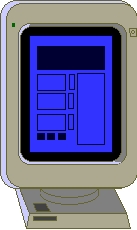 There
were amazing machines and fascinating complicated devices; the scholars
were arguing until late evening. The Chalk tried to understand what
riddles the researchers were solving in this laboratory. He was very
observant and once he realized that all the experiments conducted by the
researchers were supposed to lead to creating a very frightening thing.
It was called “a secret weapon”. The Chalk listened and watched.
The most important thing that he understood was that this “secret weapon”
could be extremely dangerous for the children with whom he had been studying
together at school, for the children that were making noise outside his
school, were playing in the school yard… The Chalk decided that he would
not participate in this devilish experiment! What could an ordinary
chalk do, a common school chalk?
There
were amazing machines and fascinating complicated devices; the scholars
were arguing until late evening. The Chalk tried to understand what
riddles the researchers were solving in this laboratory. He was very
observant and once he realized that all the experiments conducted by the
researchers were supposed to lead to creating a very frightening thing.
It was called “a secret weapon”. The Chalk listened and watched.
The most important thing that he understood was that this “secret weapon”
could be extremely dangerous for the children with whom he had been studying
together at school, for the children that were making noise outside his
school, were playing in the school yard… The Chalk decided that he would
not participate in this devilish experiment! What could an ordinary
chalk do, a common school chalk?
He began to scratch the blackboard, to crumble…
It was all that he could do. One day his behavior led to the point
when the scholars stopped arguing. The Chalk was very pleased.
However, soon everybody got tired of an uncomfortable chalk and one of
the researchers threw the Chalk into a waste basket. “Let it be",
the Chalk thought, "I won’t help them any more in these terrible experiments”. 
On the evening of the same day the basket,
where the Chalk lied, was taken outside and shaken out into a rubbish container.
During shaking the Chalk jump and flew far aside, it got on a path and
was left there till morning. He was upset and didn’t sleep all
night.
In the morning, when the rising sun colored
the roofs of the houses around, children came running to the yard.
One of the boys picked up the Chalk and right on the concrete path began
to draw “squares”. The Chalk more used to a smooth laboratory board
than to the rough asphalt, shuddered with sharp pain when the boy drew
his first rather uneven line. The Chalk couldn’t understand why the
lines were uneven, what “fire” and “water” meant. The boy tried to
make the lines thick and therefore pressed the Chalk hard. A few
seconds later half of the Chalk was left on the rough gray asphalt.
The Chalk that not long ago had been drawing the most complicated formulas,
had known lots of interesting problems, had been able during the night
collect his disassembled parts and by the morning become “new”, this Chalk
was nearly dead, drawing “squares”!!! Then the boy finished his scheme,
other children came up to him and the game started.
The Chalk was lying flat on the asphalt path.  The rules of the game were amazingly simple. At first the Chalk couldn’t
understand why everybody was fascinated by this game. But gradually
he got fascinated too, watching the kids jump on the “squares”, show interest
towards other kids’ performance. The Chalk was delighted, because
he helped the children to be fast and adroit. All was so simple:
a warm, sunny day, a comfortable, kind yard and a funny game. The
Chalk felt himself again a young piece of chalk, for the first time out
of a box and into the hands of a first grade student that began his trip
into an amazing world full of happiness and worries. The game was
going on and the kids were delighted with the warm sunny day when they
got together and peacefully and friendly played in their own comfortable
yard.
The rules of the game were amazingly simple. At first the Chalk couldn’t
understand why everybody was fascinated by this game. But gradually
he got fascinated too, watching the kids jump on the “squares”, show interest
towards other kids’ performance. The Chalk was delighted, because
he helped the children to be fast and adroit. All was so simple:
a warm, sunny day, a comfortable, kind yard and a funny game. The
Chalk felt himself again a young piece of chalk, for the first time out
of a box and into the hands of a first grade student that began his trip
into an amazing world full of happiness and worries. The game was
going on and the kids were delighted with the warm sunny day when they
got together and peacefully and friendly played in their own comfortable
yard.
The Chalk was left on the asphalt
path. But is it possible that this tale is over at this point?
Make up your own story about how the Chalk will “collect himself together”
and continue his adventure.
Last updated
on Feb. 19, 2002. Access point: Editor:
nakagawa@utc.osaka-gu.ac.jp













 There
were amazing machines and fascinating complicated devices; the scholars
were arguing until late evening. The Chalk tried to understand what
riddles the researchers were solving in this laboratory. He was very
observant and once he realized that all the experiments conducted by the
researchers were supposed to lead to creating a very frightening thing.
It was called “a secret weapon”. The Chalk listened and watched.
The most important thing that he understood was that this “secret weapon”
could be extremely dangerous for the children with whom he had been studying
together at school, for the children that were making noise outside his
school, were playing in the school yard… The Chalk decided that he would
not participate in this devilish experiment! What could an ordinary
chalk do, a common school chalk?
There
were amazing machines and fascinating complicated devices; the scholars
were arguing until late evening. The Chalk tried to understand what
riddles the researchers were solving in this laboratory. He was very
observant and once he realized that all the experiments conducted by the
researchers were supposed to lead to creating a very frightening thing.
It was called “a secret weapon”. The Chalk listened and watched.
The most important thing that he understood was that this “secret weapon”
could be extremely dangerous for the children with whom he had been studying
together at school, for the children that were making noise outside his
school, were playing in the school yard… The Chalk decided that he would
not participate in this devilish experiment! What could an ordinary
chalk do, a common school chalk?

 The rules of the game were amazingly simple. At first the Chalk couldn’t
understand why everybody was fascinated by this game. But gradually
he got fascinated too, watching the kids jump on the “squares”, show interest
towards other kids’ performance. The Chalk was delighted, because
he helped the children to be fast and adroit. All was so simple:
a warm, sunny day, a comfortable, kind yard and a funny game. The
Chalk felt himself again a young piece of chalk, for the first time out
of a box and into the hands of a first grade student that began his trip
into an amazing world full of happiness and worries. The game was
going on and the kids were delighted with the warm sunny day when they
got together and peacefully and friendly played in their own comfortable
yard.
The rules of the game were amazingly simple. At first the Chalk couldn’t
understand why everybody was fascinated by this game. But gradually
he got fascinated too, watching the kids jump on the “squares”, show interest
towards other kids’ performance. The Chalk was delighted, because
he helped the children to be fast and adroit. All was so simple:
a warm, sunny day, a comfortable, kind yard and a funny game. The
Chalk felt himself again a young piece of chalk, for the first time out
of a box and into the hands of a first grade student that began his trip
into an amazing world full of happiness and worries. The game was
going on and the kids were delighted with the warm sunny day when they
got together and peacefully and friendly played in their own comfortable
yard.